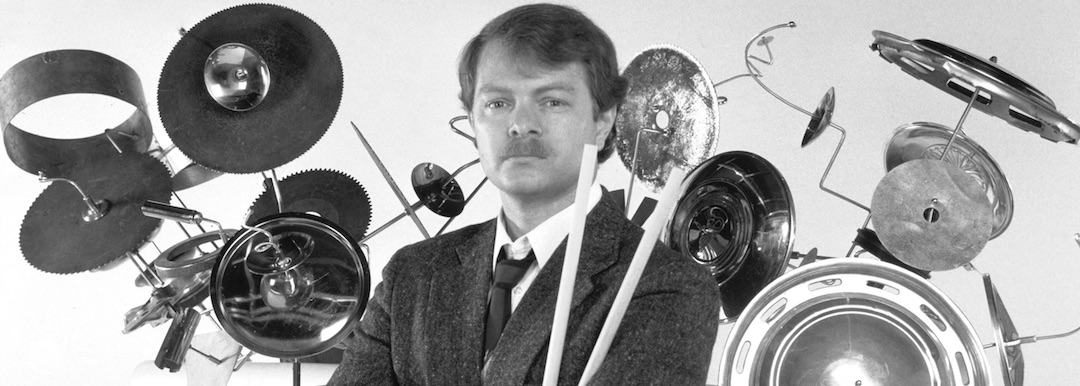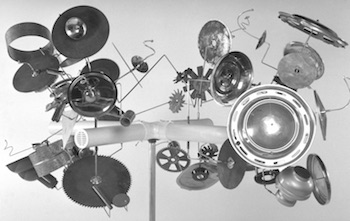 |
||
| Scrapercussion 2024 by Dan Senn |
#7 Acoustic Recordings
1989 Eight Improvisations on a Sound Sculpture Total duration of about 35 minutes. |
|
| The Scraperussion #7 Feedback Recordings
1989, 1991 were recorded on June 5, 1989 while the student led Tiananman
Square protests and massacre were occuring. As a closer
observer of international politics I was keenly aware of this event
causing me to name one of the improvs made that day after the event
(not included here for technical problems). The
recording took place in
the Fine Artis Computer Lab I had designed and taught out of as an
Associate Professor of Music and Lab Coordinator, the students absent,
on summer break. An Associate Professor at Ball State University, I was committed to teaching interdisciplinary art as applied to emerging digital technologies, I was first an artist. Communication with students was important and improved through personal growth and individuation. These soundsculptures, and I built 10, #7 now in the Sylvia Smith Archive at the University of Akron, were exceptional that interarts research was viewed with deep suspicion—Cleve Scott and Larry Graham brave exceptions. The scrapercussions were by nature problematic as they were concieved as 1) sculptures to be seen and not heard, 2) instruments to be heard and not seen, and 3) mobile dance "partners" to be pushed, pulled, flung throughout the dance space, interacted with by dancers and patrons alike. In an early outing at the Links Gallery in Canberra, Australia (I was then a Lecturer I in Electronic Music Composition at the Canberra School of Music), these also acted as the antenna for a Theremin sensing the proximity of patrons. It wasn't until about 1987, while in Muncie, IN, that I discovered their role as feedback instruments in live performance. The Scrapercussions are comprised of found resonant, metal objects from garage sales and thrift stores. Each item, or resonator, is chosen for sonic qualities when tapped (an embarrassment to my kids while so shopping) but also for shape, and, at times, social function. These are "suspended" around and through a pvc chassis using 1/4" rods that were threaded on end to form a metallic continuum where the PVC chassis acts passively. When striking a resonator, or rod connector, in this continuum is to hear a composite, sonic identity for that sound sculpture representing, paradoxically, the planned, interdisciplinary essence of the instrument. In these instruments, this fact is not a bland byproduct but a facilitating necessity as visual, sonic and symbolic features (i.e. a shot cup) spin in multiple, inter-related directions. It is this considerateness that spurs the anthropomorphisms ... |
Click titles below to hear
works. Please use headphones or an expensive sound system. Aussie Fan 1 (3'11") uses two 8" long 3/16" diameter steel rods to strike an delightful aluminum fan found at a Canberra junk yard in 1984. Out On Limb One (6'04") was performed on one of the 4 wings of Scraperussion #7, I don't remember, using the wooden dowels given iin the banner photo above. Two Sticks (7'34") mainly focuses on the rod connetors and chassis of #7 again usng the dowels pictured above. Out On Limb Two (6'04") was performed on another one of the 4 wings of Scraperussion #7. Four Sticks with Shortnin' Bread (2'48") is similare to Two Sticks accept the dowels are no 3/16" in diametter and 18" long, with fftwo in each hand meaning I had less control by choice. My aim here was to imitiate, albeit clumsily, the rhythm of this negro spiritual and at some point join in singing the first line of the tune over and over as picked up by the piezos mics on the instrument. Out On Limb Three & Four (6'04") was performedon the remaining two wings of #7. Aussie Fan 2 (3'48") aslo uses 8" long 3/16" steel rods on an aluminum fan found at a metal juck yard in Canberra in 1984. Another take. Late Takes (5'15"), a recording also included the Shy Anne Studio Recordings, is performed virtually using Joel Chadabe's brilliant M software. The resonators of this sound sculpture were sampled for M and algorithmically performed while audience members tossed coins at the instrument. A humorous work, coughing political overtones while sonically and theatrically effective. Click to enlarge.  The Scrapercussion soundsculptors led to a group of related instruments by Dan Senn. This photo is from the Krannert Center for the Performing Arts in 1993. |
... that flow from scraperussion from
dancers. While in fun, all this, it
is an irony that confuses others stuck in the eight bar phrase. And the
continuums
essential to this system are key to the
effectiveness of scrapercussions as a feedback source as described and
demonstrated here. While teaching in Australia, 1980-84, working with the first 6 Scrapercussions, I wished to amplify them using contact microphones but these were quite expensive. Back in the US, years later at BSU, I discovered inexpensive piezo transducers used by some fluxus artists like Paul Panhuysen. I had become acquainted with many fluxus artists, especially in Europe, assisted by Phill Niblock in New York City. Richard Lerman sent me circuit diagrams that I integrated into my existing scrapercussions and instruments to come. DS 041024 Click
to enlarge.
Dan Senn (Prague-Watertown) is an intermedia artist working in music composition and production, kinetic sound sculpture, experimental and documentary film. He has been a professor of music and art in the United States and Australia and travels internationally as a lecturer, performer and installation artist. He lives in Prague where he directs the Echofluxx festivals, and Watertown, Wisconsin, the USA, with his partner-collaborator, Caroline Senn. Dan's work moves freely between expressive extremes and languages depending upon the aesthetic joust at hand. Dan is cofounder of Roulette Intermedium in New York City, Cascadia Composers of Portland Oregon, and the Echofluxx media festivals in Prague. (read more). |
